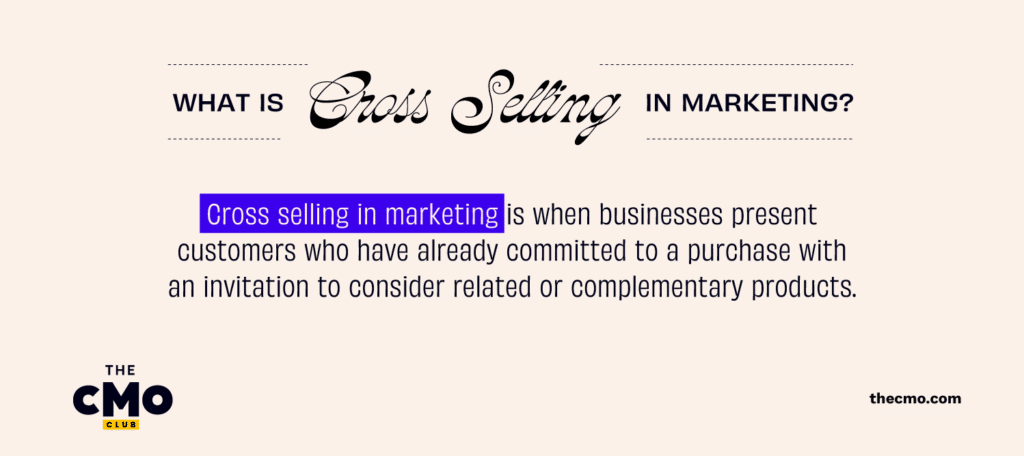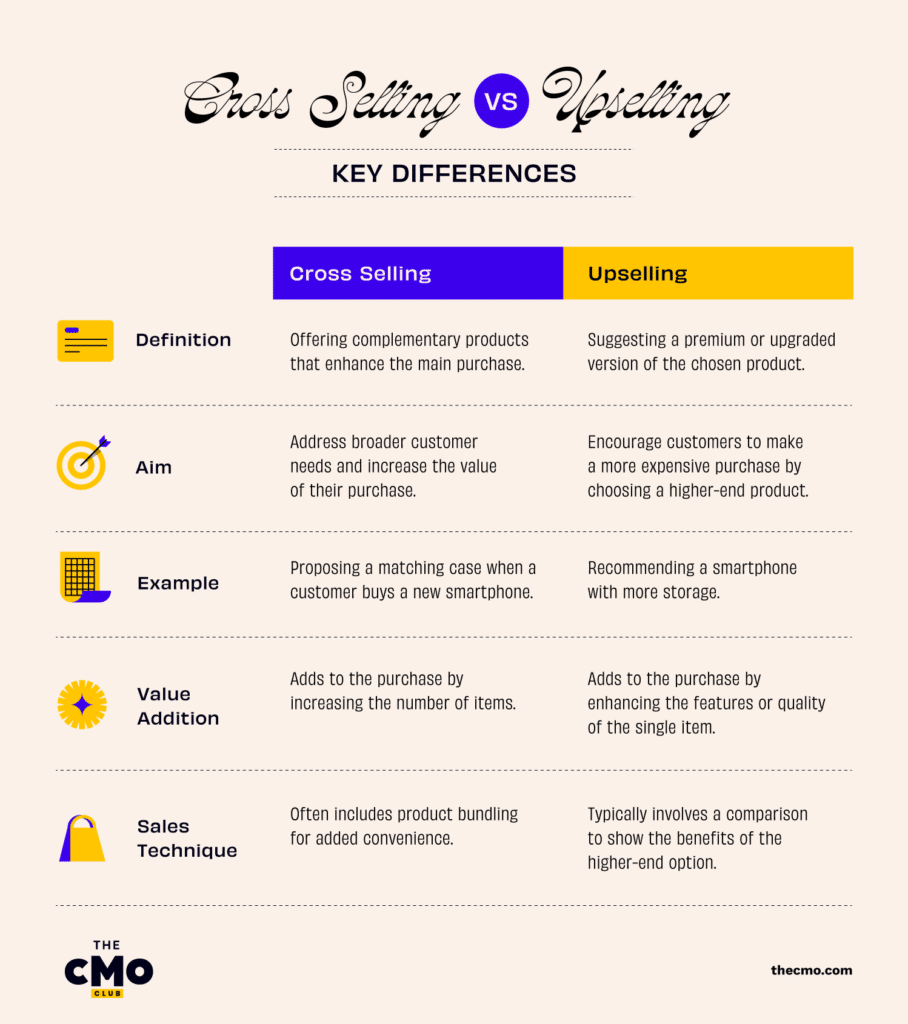Struggling to maximize sales from each customer interaction? Cross selling in marketing might be the answer you're looking for. This strategy not only increases sales by presenting related products to customers but also improves their experience with your brand.
In this article, I'll share how cross selling can enhance customer loyalty and lead to the growth of your business, detailing the benefits and best practices to help you implement this technique effectively.
What Is Cross Selling In Marketing?

Cross selling in marketing is when businesses present customers who have already committed to a purchase with an invitation to consider related or complementary products. This technique offers a dual benefit, addressing the customer’s needs while enhancing customer lifetime value (CLV).
Think about it—successfully cross-sold items can transform a single purchase into a more comprehensive solution for the customer, cementing their relationship with the brand. For the business, it increases revenue and ultimately adds to the bottom line.
In its best form, it’s a win-win: customers feel understood and appreciated, while businesses enjoy the fruits of increased revenue and a stronger bond with their clientele. Combined, this all leads to:
- Increased customer satisfaction
- Higher revenue
- Stronger customer loyalty
- Greater business growth
Cross selling vs. upselling: key differences
While cross selling and upselling are often mentioned in the same breath, they are distinctly different. Cross selling invites customers to consider additional, different products that enhance their main purchase, like a matching case for a new smartphone or a warranty for a laptop.
Upselling, on the other hand, is the art of encouraging customers to ascend to a more premium version of what they’re already buying, such as suggesting a phone with more storage capacity.

Understanding the nuances between cross selling and upselling is paramount for a sales rep aiming to maximize their art. Balancing these strategies can lead to an impressive boost in sales and profits, often to the tune of 20% to 30%, and can account for an average of 21% of organizational revenue.
Importance Of Cross Selling In Marketing
Cross selling plays a vital role in both marketing and overall business strategies. By proposing products that match customer interests and purchases, sales leaders can reap substantial revenue growth and increased CLV. The beauty of cross selling lies in its efficiency, as it's far easier to expand business with an existing customer than it is to woo a new one.
If that isn't enough to convince you, just take a look at these stats:
- According to HubSpot, companies implementing cross selling strategies have seen an increase in revenue of up to 30%.
- According to a LinkedIn study, just under 50% of consumers have admitted to making an impulse purchase following a recommendation.
- According to Gitnux, personalized recommendations based on customer data have resulted in a 35% increase in sales.
Examples Of Cross Selling In Marketing

Cross selling manifests in various forms across industries, but none may be quite as clear as the fast-food sector. Take McDonalds, for example, who masterfully suggests adding fries or a drink to your burger order—a classic cross sell that satisfies hunger and boosts the average order value.
In the tech world, cross selling strategies involve suggesting compatible accessories or software that complement the customer’s primary purchase, delivering a more comprehensive technology experience. Whether it’s through email marketing, on product pages, or during customer service interactions, cross selling helps you offer more value and generate additional revenue.
Benefits Of Cross Selling
Cross selling offers a wide range of benefits, like increasing revenue by encouraging customers to purchase products that serve as the perfect accompaniments to their initial buys. By bundling related products, businesses not only make it convenient for customers to get everything they need in one place, but also boost their chances of selling less popular items.
Some benefits of cross selling include:
- Increased revenue
- Improved customer satisfaction
- Increased customer loyalty
- Increased average order value
- Increased product visibility
Cross selling is also a powerful tool for building brand loyalty. As customers become familiar with a broader range of a company’s products, they are more likely to return for future needs, reducing the likelihood of them turning to competitors. All in all, cross selling creates a one-stop-shop experience that fosters a deeper, more loyal customer relationship.
Challenges Of Cross Selling
Despite its benefits, cross selling comes with its own set of challenges that must be managed to maintain healthy customer relationships. When incorrectly implemented, cross-selling efforts can backfire, resulting in eroded profits, dissatisfied customers, and a tarnished company reputation.
Avoiding customer annoyance
During cross-selling, timing and tact are critical to prevent customer annoyance. Offers should be presented when customers are most likely to be receptive, such as after a positive brand interaction or when they are in the process of making a purchase.
By involving customers in the decision-making process and valuing their feedback, businesses can create a cross-selling experience that feels personalized and respectful, rather than intrusive. After a cross-selling transaction, following up with customers to ensure their satisfaction can also reinforce a positive brand experience.
Ensuring relevance
Effective cross-selling is fundamentally based on relevance. Personalized recommendations that align with customer behaviors and preferences demonstrate an understanding of their needs and can greatly increase the chances of a successful cross sell. To ensure relevance, businesses must avoid suggesting products or services that do not genuinely complement or enhance the customer’s original purchase.
Price sensitivity is also an important consideration in maintaining customer satisfaction. Recommending complementary products priced reasonably in relation to the original purchase helps respect the customer’s budget and increases the likelihood of repeat business.
Maintaining ethical business practices
Rather than merely boosting sales figures, ethical cross-selling focuses on enhancing the customer’s experience. The primary goal should always be to provide genuine value, which in turn will naturally lead to increased revenue. You want to avoid unethical practices such as deceptive upsells or cross-sells, which can severely damage a store’s reputation and customer trust.
This involves using open-ended questions, practicing active listening, and demonstrating empathy. Avoiding aggressive or deceptive tactics not only maintains the integrity of the business but also builds a foundation of trust that encourages repeat business and customer referrals.
How To Use Cross Selling In Marketing
Effective cross-selling in marketing requires four simple steps, which I've outlined below, all whilst ensuring clear value, relevance, and proper timing.
1. Identify related products and services
The first step in developing a customer-centric cross-selling strategy is to identify related products and services. Creating product bundles or offering complementary items can greatly enhance the value of a customer’s purchase. For example, offering a discount on a tire pump when a customer buys a new bike not only saves them time but makes their purchase more satisfying.
SaaS businesses and other companies often increase the perceived value of their offerings by presenting product bundles at a discounted rate, which encourages customers to invest in a more comprehensive solution. Cross-selling should always be focused on offering additional products that genuinely complement the customer’s initial purchase, ensuring it adds real value.
2. Identify suitable customers
The next step is to identify the right existing customers for cross-selling efforts. Understanding their buying journey and previous purchases allows you to align potential cross-sell opportunities with the right audience. Leveraging sales and marketing software equipped with CRM and AI-assisted sales analytics can also help you organize customer purchase histories and interactions, making it easier to fit the right customers with the right offers.
Automated AI tools can take this a step further by reaching out to customers who have shown interest in specific products, initiating cross-sell offers without the need for manual campaign setups each time. This level of personalization and efficiency can significantly enhance the effectiveness of cross-selling campaigns and ensure that offers truly resonate.
3. Utilize multiple channels
Using multiple channels can greatly enhance the success of cross-selling campaigns. By employing a variety of platforms and points of contact, businesses can reach customers through their preferred channels, whether it’s email, social media, or in-person interactions.
The conversion of identified cross-sell customers into actual sales hinges on the method of contact. Testing different approaches across multiple channels and refining them based on performance analytics can lead to higher conversion rates.
4. Personalize recommendations
Finally—and as with so many other things in marketing—the success of cross-selling strongly depends on personalized recommendations. By analyzing real-time data on customer behavior, you'll be able to offer personalized product suggestions that significantly increase the likelihood of a cross-sell conversion.
Educating customers about the benefits and use cases of complementary products can also reduce resistance to additional customer purchases. The modern consumer expects a personalized service, and the tools to deliver such experiences are readily available. By harnessing solid data to inform cross-selling efforts, you can ensure that recommendations are relevant and timely.
Best Tools For Cross Selling In Marketing
The right tools can make all the difference in optimizing your cross-selling strategy. Marketing CRM software is key for maintaining up-to-date client information, which can then be analyzed to provide personalized cross-selling recommendations, and marketing analytics tools are equally indispensable for managing and monitoring multichannel cross-selling campaigns.
There are a lot of tools out there, so here I'll share some of my favorites:
Best Marketing Software
Selecting the right tools depends on the specific needs of the business, but the strategic mindset remains the same: to provide a personalized and effective cross-selling experience.
Measuring Cross Selling Success
Evaluating cross-selling success is essential for making informed and strategic decisions. Keep an eye on key performance indicators (KPIs) like:
- Cross-sell rate, which measures the proportion of revenue from cross-sells relative to overall revenue. A low rate may indicate that your approach needs refinement.
- Conversion rate of cross-sell offers, indicating the percentage of targeted customers who accept the cross-sell proposition.
- Customer retention rate, as successful cross-selling can contribute to repeat purchases and customer loyalty.
- Product penetration rate, which shows how many different products a customer has purchased from your portfolio.
- Average order value (AOV), which reflects the average monetary amount customers spend per transaction. A rise in AOV is often a sign that your efforts are resonating with customers.
- Customer satisfaction score (CSAT), which can help gauge the impact of cross-selling on the customer's perception of your brand.
Keep in mind that these rates can vary significantly across industries, and you'll want to measure success through evaluating cross-selling effectiveness through KPIs, customer feedback, and A/B testing.
Join For More Marketing Insights
Cross-selling in marketing, when applied with customer insight and ethical practices, can transform an ordinary purchase into an extraordinary customer experience. It requires a fine balance of timing, relevance, and personalization, supported by the right tools and measured by key performance indicators for constant improvement. Let me leave you with these three takeaways:
- Cross selling is a marketing strategy that offers customers complementary products or services, aiming to enhance their initial purchase and increase business revenue whilst also improving customer satisfaction and loyalty.
- The technique relies on understanding customer needs and timing, using personalized recommendations, and making use of various channels to present relevant cross-sell offers without appearing intrusive or pushy.
- Implementing an effective cross selling strategy involves identifying related products and suitable customers, using CRM and analytics tools to track success, and continually measuring performance through KPIs.
If you enjoyed this article or want to learn more about different marketing strategies, be sure to subscribe to The CMO newsletter. You'll get all of the best tips and expert insights straight to your inbox.
Frequently Asked Questions
What is the difference between cross-selling and upselling?
The main difference between cross-selling and upselling is that cross-selling suggests complementary products, while upselling promotes a more premium version of the product. Cross-selling recommends additional items, while upselling encourages an upgrade.
How can I avoid annoying customers with cross-selling?
To avoid annoying customers with cross-selling, time your offers when they are most receptive, involve them in the decision-making process, and follow up to ensure satisfaction. Providing value is key to successful cross-selling.
Which tools can help with cross-selling in marketing?
To effectively cross-sell in marketing, consider using CRM and analytics tools such as Salesforce CRM, HubSpot CRM, and Google Analytics. We have more great recommendations and reviews on our website.
What are some key performance indicators for measuring cross-selling success?
Key performance indicators to measure cross-selling success include the cross-sell rate, average order value (AOV), and lifetime value (LTV). These metrics assess the impact of cross-selling strategies and customer engagement in the long run.
What are the main benefits of cross-selling?
Cross-selling offers a range of benefits, including increased revenue, customer satisfaction, and brand loyalty, as well as the opportunity to sell less popular items and meet all customer needs. Start implementing cross-selling strategies to experience these advantages firsthand.


